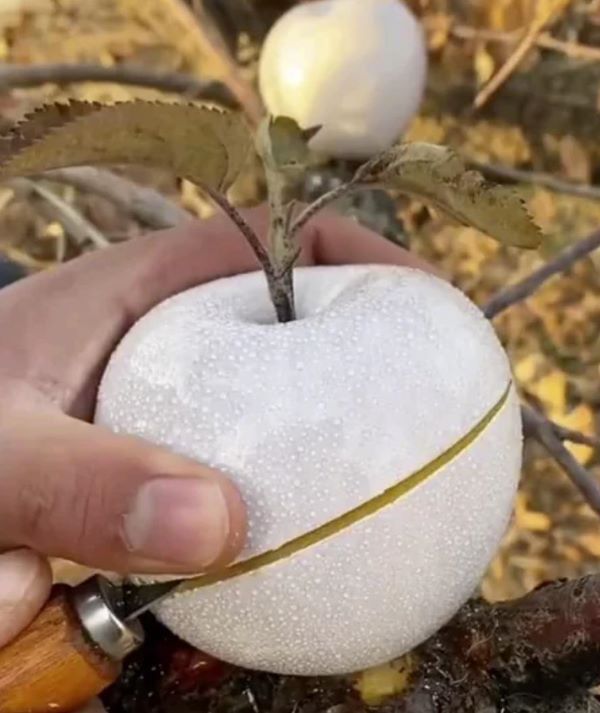Ghost apple, or white apple, is a brand-new, one-of-a-kind variety from Zaiger Genetics. The ghost apple is a small tree that is often grown for its edible properties. It produces apples with practically white skin (called “pomes” in botanical terminology) and white flesh that are ready to be picked in the early to mid-summer. The flowering season is early spring, and it needs regular water to grow. These apples are ripe in early July; they love the full sun and require a pollinizer like Fuji, Gala, Granny Smith, or Pink Lady.
With a breathtaking white flesh and skin, ghost apples have a sweet, sub-acid flavor with a crisp texture. At maturity, Ghost Apple will reach a height of around 15 feet and a spread of 14 feet. It can be planted under power lines because of its low canopy, which typically has a clearance of 4 feet above ground. The unusually white fruits are produced in large quantities from late spring to midsummer. This rare white-skinned apple, which was developed in the hot interior of central California, has a low chill requirement and can tolerate temperatures as high as 110 °F without becoming scorched.
Read More: The Rare Tibetan Black Diamond Apple
Ghost Apple has forest green leaves all season long and boasts spectacular clusters of softly fragrant white flowers with shell pink undertones along the branches in mid-spring, which bloom from unique rose flower buds. If the fruit falls on the grass or sidewalks, it might get dirty and need to be cleaned up now and then. If the fruit falls on the grass or sidewalks, it might get dirty and need to be cleaned up now and then. Due to its mature size and spread, this tree is usually cultivated in a specially designated section of the yard, and it needs full sunlight. This interspecific hybrid variety is highly tolerant of urban pollutants and will even survive in inner-city areas. It prefers to grow in average-to-moist conditions and should not be allowed to dry out. It is not finicky about the type of soil or pH.
This is a high-maintenance tree that will need regular care and upkeep; it is best pruned in late winter once the threat of extreme cold has passed. It is a deciduous tree with an increasingly or less rounded form. Although its typical texture fades into the surroundings, one or two rougher or finer trees or bushes might counterbalance it to create a composition that is harmonious. Adaptable to high chill, but performs well in hot, low-chill situations. This variety needs a separate selection of the same species growing nearby to set fruit; it grows at a medium rate and can be anticipated to live for 50 years or more under perfect circumstances.
The following feature(s) that might require extra attention should be known to gardeners:
-
Messy
-
Shade
-
Accent
-
Orchard/Edible Landscaping
-
Disease
Read More: Apples – Potent Source of Antioxidants
-

Ghost apple, or white apple, is a brand-new, one-of-a-kind variety from Zaiger Genetics. The ghost apple is a small tree that is often grown for its edible properties. 
It produces apples with practically white skin (called “pomes” in botanical terminology) and white flesh that are ready to be picked in the early to mid-summer. Source 
These apples are ripe in early July; they love the full sun and require a pollinizer like Fuji, Gala, Granny Smith, or Pink Lady. 
This is a high-maintenance tree that will need regular care and upkeep; it is best pruned in late winter once the threat of extreme cold has passed. Source